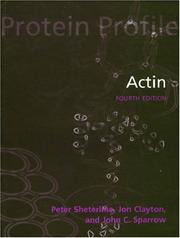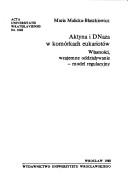| Listing 1 - 10 of 72 | << page >> |
Sort by
|

ISBN: 0198504632 Year: 1998 Publisher: Oxford New York Oxford University Press
Abstract | Keywords | Export | Availability | Bookmark
 Loading...
Loading...Choose an application
- Reference Manager
- EndNote
- RefWorks (Direct export to RefWorks)

ISBN: 8322902697 Year: 1988 Publisher: Wrocław Wydawnictwo uniwersytetu Wrocławskiego
Abstract | Keywords | Export | Availability | Bookmark
 Loading...
Loading...Choose an application
- Reference Manager
- EndNote
- RefWorks (Direct export to RefWorks)
Actin --- Deoxyribonucleases --- Eukaryotic cells
Book
Year: 2010 Publisher: [Gaithersburg, Md.] : U.S. Department of Commerce, National Institute of Standards and Technology,
Abstract | Keywords | Export | Availability | Bookmark
 Loading...
Loading...Choose an application
- Reference Manager
- EndNote
- RefWorks (Direct export to RefWorks)
Cell organelles --- Actin --- Identification --- Mathematical models.
Book
ISBN: 0306444525 Year: 1993 Publisher: New York Plenum Press,
Abstract | Keywords | Export | Availability | Bookmark
 Loading...
Loading...Choose an application
- Reference Manager
- EndNote
- RefWorks (Direct export to RefWorks)
Cytoplasmic filaments - Congresses. --- Actin - Congresses. --- Myosin - Congresses.
Book
ISBN: 0306448106 1461361028 1461525780 Year: 1994 Volume: 358 Publisher: New York, NY : Plenum Press,
Abstract | Keywords | Export | Availability | Bookmark
 Loading...
Loading...Choose an application
- Reference Manager
- EndNote
- RefWorks (Direct export to RefWorks)
Actin --- Congresses --- Cytoplasmic filaments --- ACTINS --- MICROFILAMENT PROTEINS --- CONGRESSES
Book
Year: 2017 Publisher: Frontiers Media SA
Abstract | Keywords | Export | Availability | Bookmark
 Loading...
Loading...Choose an application
- Reference Manager
- EndNote
- RefWorks (Direct export to RefWorks)
The present E-book, consisting of a compilation of original articles and reviews, presents how myofilaments are regulated in cardiac and skeletal muscles and trigger contraction. Additionally, this E-book gives insights into their dysregulation in a number of muscle disorders.
Heart --- Actin --- Myosin --- Muscle --- skeletal muscle --- Contraction --- sarcomere --- Myopathy
Book
Year: 2020 Publisher: Frontiers Media SA
Abstract | Keywords | Export | Availability | Bookmark
 Loading...
Loading...Choose an application
- Reference Manager
- EndNote
- RefWorks (Direct export to RefWorks)
The coordinated action of the different cytoskeletal polymers--microtubules, actin filaments and neurofilaments-- is essential for the establishment, remodeling and maintenance of neuronal architecture throughout the neuron lifetime. Neurons are among the most polarized cells, with a long thin axon and multiple thicker and shorter dendrites. Achieving this complex morphology, and the precise and accurate formation of an intricate network of synaptic contacts is critical for the proper transmission and reception of signals in the brain. Neuronal polarization precedes axon outgrowth and the subsequent differentiation of short neurites into dendrites, as part of the neuronal differentiation program that involves both intrinsic and extrinsic signals that converge at the cytoskeletal level. Growth cones, which are sensory and locomotor structures located at the tip of growing axons, are key elements in the transduction of extracellular cues into cytoskeletal changes, guiding axons to their right destinations. Neuronal migration, another crucial process during brain development, occurs in close coordination with neuronal differentiation. Migration involves as well an extensive rearrangement of neuronal cell shape that relies on cytoskeleton reorganization. Further processes, such as dendritic spine formation and growth, establishment of synaptic contacts or synaptic plasticity in mature neurons also depend on cytoskeletal dynamics. Fine-tune regulation of neuronal cytoskeleton is therefore crucial for the maintenance of neuronal integrity and functionality. Mutations in genes that code for cytoskeletal proteins often have deleterious effects in neurons, such as abnormal migration or differentiation, deficient axonal transport of organelles and synaptic vesicles, or impaired synaptic signaling. Several human Nervous System disorders, including neurodevelopmental, psychiatric, and neurodegenerative diseases, have been linked to cytoskeletal dysfunction. Cytoskeletal reorganization is also crucial to regulate nerve cell repair following Nervous System injury. Many of the pathways that control cell-intrinsic axon regeneration lead to axon cytoskeletal remodeling. Moreover, most extracellular cues that inhibit regeneration of damaged axons in Central Nervous System following traumatic injury or neurodegeneration, are known to modulate cytoskeletal dynamics and organization. Based on these findings, regulators of cytoskeleton dynamics have emerged as promising therapeutic targets in several brain disorders and in the context of regeneration of injured axons. Hence, remodeling of neuronal cytoskeleton underlies all the dramatic morphological changes that occur in developing and adult neurons. Understanding the specific molecular mechanisms that control cytoskeleton rearrangements in neurons is far from complete. This Frontiers Research Topic gathers a selection of articles focused on the diverse and key roles of cytoskeleton in neuronal biology.
neuronal cytoskeleton --- astrocyte cytoskeleton --- microtubules (MTs) --- actin cytoskeleton --- tau --- neuron
Book
Year: 2017 Publisher: Frontiers Media SA
Abstract | Keywords | Export | Availability | Bookmark
 Loading...
Loading...Choose an application
- Reference Manager
- EndNote
- RefWorks (Direct export to RefWorks)
The present E-book, consisting of a compilation of original articles and reviews, presents how myofilaments are regulated in cardiac and skeletal muscles and trigger contraction. Additionally, this E-book gives insights into their dysregulation in a number of muscle disorders.
Heart --- Actin --- Myosin --- Muscle --- skeletal muscle --- Contraction --- sarcomere --- Myopathy
Book
Year: 2017 Publisher: Frontiers Media SA
Abstract | Keywords | Export | Availability | Bookmark
 Loading...
Loading...Choose an application
- Reference Manager
- EndNote
- RefWorks (Direct export to RefWorks)
The present E-book, consisting of a compilation of original articles and reviews, presents how myofilaments are regulated in cardiac and skeletal muscles and trigger contraction. Additionally, this E-book gives insights into their dysregulation in a number of muscle disorders.
Heart --- Actin --- Myosin --- Muscle --- skeletal muscle --- Contraction --- sarcomere --- Myopathy --- Heart --- Actin --- Myosin --- Muscle --- skeletal muscle --- Contraction --- sarcomere --- Myopathy
Book
Year: 2020 Publisher: Frontiers Media SA
Abstract | Keywords | Export | Availability | Bookmark
 Loading...
Loading...Choose an application
- Reference Manager
- EndNote
- RefWorks (Direct export to RefWorks)
The coordinated action of the different cytoskeletal polymers--microtubules, actin filaments and neurofilaments-- is essential for the establishment, remodeling and maintenance of neuronal architecture throughout the neuron lifetime. Neurons are among the most polarized cells, with a long thin axon and multiple thicker and shorter dendrites. Achieving this complex morphology, and the precise and accurate formation of an intricate network of synaptic contacts is critical for the proper transmission and reception of signals in the brain. Neuronal polarization precedes axon outgrowth and the subsequent differentiation of short neurites into dendrites, as part of the neuronal differentiation program that involves both intrinsic and extrinsic signals that converge at the cytoskeletal level. Growth cones, which are sensory and locomotor structures located at the tip of growing axons, are key elements in the transduction of extracellular cues into cytoskeletal changes, guiding axons to their right destinations. Neuronal migration, another crucial process during brain development, occurs in close coordination with neuronal differentiation. Migration involves as well an extensive rearrangement of neuronal cell shape that relies on cytoskeleton reorganization. Further processes, such as dendritic spine formation and growth, establishment of synaptic contacts or synaptic plasticity in mature neurons also depend on cytoskeletal dynamics. Fine-tune regulation of neuronal cytoskeleton is therefore crucial for the maintenance of neuronal integrity and functionality. Mutations in genes that code for cytoskeletal proteins often have deleterious effects in neurons, such as abnormal migration or differentiation, deficient axonal transport of organelles and synaptic vesicles, or impaired synaptic signaling. Several human Nervous System disorders, including neurodevelopmental, psychiatric, and neurodegenerative diseases, have been linked to cytoskeletal dysfunction. Cytoskeletal reorganization is also crucial to regulate nerve cell repair following Nervous System injury. Many of the pathways that control cell-intrinsic axon regeneration lead to axon cytoskeletal remodeling. Moreover, most extracellular cues that inhibit regeneration of damaged axons in Central Nervous System following traumatic injury or neurodegeneration, are known to modulate cytoskeletal dynamics and organization. Based on these findings, regulators of cytoskeleton dynamics have emerged as promising therapeutic targets in several brain disorders and in the context of regeneration of injured axons. Hence, remodeling of neuronal cytoskeleton underlies all the dramatic morphological changes that occur in developing and adult neurons. Understanding the specific molecular mechanisms that control cytoskeleton rearrangements in neurons is far from complete. This Frontiers Research Topic gathers a selection of articles focused on the diverse and key roles of cytoskeleton in neuronal biology.
Science: general issues --- Neurosciences --- neuronal cytoskeleton --- astrocyte cytoskeleton --- microtubules (MTs) --- actin cytoskeleton --- tau --- neuron --- neuronal cytoskeleton --- astrocyte cytoskeleton --- microtubules (MTs) --- actin cytoskeleton --- tau --- neuron
| Listing 1 - 10 of 72 | << page >> |
Sort by
|

 Search
Search Feedback
Feedback About UniCat
About UniCat  Help
Help News
News